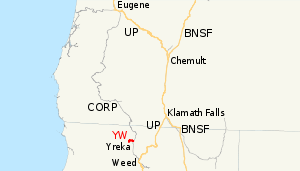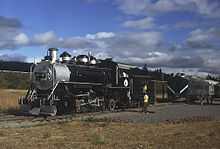Yreka Western Railroad
| Yreka Western Railroad | |
|---|---|
| Blue Goose | |
 | |
| An ALCO MRS-1 at Yreka station. | |
 | |
| Commercial operations | |
| Original gauge | 4 ft 8 1⁄2 in (1,435 mm) standard gauge |
| Preserved operations | |
| Owned by | Rocky Mountain Railroad & Mining Museum |
| Operated by | Rocky Mountain Railroad & Mining Museum |
| Reporting mark | YW |
| Preserved gauge | 4 ft 8 1⁄2 in (1,435 mm) standard gauge |
| Commercial history | |
| Opened | 1889 |
| 1888 | Yreka Railroad incorporated |
| 1889 | Opened |
| 1933 | The new Yreka Western Railroad incorporated |
| (?) | Kyle Railways |
| Closed | No, Freight service continued |
| Preservation history | |
| 1986 | Steam excursions started |

The Yreka Western Railroad (reporting mark YW) is an 8.86-mile (14.26 km) shortline railroad that operates freight and tourist trains between the Central Oregon and Pacific Railroad at Montague and the city of Yreka, California.[1] It began operations in 1935 on a line that was placed in service in 1889, and has remained independent of larger carriers.[2]
History
The Yreka Railroad was incorporated in May 1888, with a capital stock of $100,000, to serve local mines,[3] and opened in January 1889, connecting Yreka to the Southern Pacific Company lessor Central Pacific Railroad (ex-California and Oregon Railroad). In August 1933, the new Yreka Western Railroad was incorporated, and it took over the property in April 1935.[2] The Central Oregon and Pacific Railroad acquired the SP connection at Montague in 1994.
Operations
In recent years, the railroad was owned by Kyle Railways and provided freight service and offered passenger train excursions. The freight traffic is primarily wood chips and forest products. Today, the line is a tourist railroad and is owned and operated by the Rocky Mountain Railroad & Mining Museum of Denver, Colorado.
In 1986 the YW started operating a steam passenger train excursion known as the "Blue Goose" between Yreka and Montague. The "Blue Goose" continues to operate to this day. The railroad offers scenic views of Mount Shasta and the Siskiyou Mountains. The trip takes about one hour in either direction, with a 60 to 90-minute layover in Montague depending on the number of passengers. While passengers explore and eat in Montague, the crew takes the train to perform a runaround move so the locomotive will pull the train back to Yreka.
The most famous locomotive on the line is 2-8-2 Baldwin 90 ton logging mikado #19. #19 is nicknamed "Pancho" due to its time spent in Mexico in the 1920s and possible squabble with the Mexican revolutionary Pancho Villa. #19 has starred in many movies, the two most famous being "Emperor of the North" and "Stand By Me". She was built in 1915 by Baldwin for the Caddow River Lumber Company in Arkansas. She served there until being sent to Mexico in 1920 where she is believed to have been converted to oil. In 1924 she was purchased by the McCloud River Railroad. She served many years there hauling log trains until being sold to the Yreka Western Railroad in 1953.
Other locomotives include SW8 #21, SD9 #439, and ALCO MRS-1 #244. #21 (Former Southern Pacific #1115) is usually used in freight service, but is occasionally put into excursion service when the #19 needs repairs. #21 is unique because it has dynamic brakes, not usually found on switching locomotives.
See also
References
- ↑ See Stephens, Kent. "The Yreka Western Railroad -- A Centennial History." (1992, Northstate Publishing).
- ↑ 2.0 2.1 Edward A. Lewis, American Shortline Railway Guide, 5th Edition, Kalmbach Publishing, 1996, p. 346
- ↑ Interstate Commerce Commission, 108 I.C.C. 677 (1926): Valuation Docket No. 292, Yreka Railroad Company
External links
| Wikimedia Commons has media related to Yreka Western Railroad. |
| |||||||||||||||||||||||||
